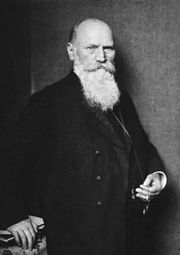Heinrich Wilhelm Gottfried von Waldeyer-Hartz's Human Design Chart
5/1 Lunar ReflectorGerman anatomist, famous for consolidating the neuron theory of organization of the nervous system and for naming the chromosome. He is also remembered in two macroanatomical structures of the human body which were named after him: Waldeyer’s tonsillar ring (the lymphoid tissue ring of the naso- and oropharynx) and Waldeyer’s glands (of the eyelids).
Waldeyer’s name is sometimes associated in neuroscience with the so-called “neuron theory” and for popularizing the term “neuron” to describe the basic structural unit of the nervous system. Waldeyer used the path-breaking discoveries by neuroanatomists (and later Nobel Prizewinners) Camillo Golgi (1843–1926) and Santiago Ramón y Cajal (1852–1934), who had used the silver nitrate method of staining nerve tissue (Golgi’s method) to formulate a short brilliant synthesis, even though he did not contribute with any original observations.
This method allowed them to study in exquisite detail the branching processes of nerve cells (axons anddendrites) and how they seemed to interconnect among themselves, forming chains and neural networks which could explain the physiological mechanisms underlying the phenomena of information transfer between neurons. Waldeyer learned Spanish in order to absorb Cajal’s extraordinary detailed studies using Golgi’s method and became his friend, mentor and promoter in the German-dominated field of microscopic anatomy. The theory was published in a series of papers in the main medical journal of Germany, Deutsche Medizinische Wochenschrift, which became extremely influential. However, as Cajal points out, though Waldeyer “supported the theory with the prestige of his authority, he did not contribute a single personal observation. He limited himself to a short brilliant exposition of the objective proofs, adduced by His, Kölliker,Retzius, van Gehuchten and myself, and he invented the fortunate term neuron. ” Cajal’s continuing hard work on the following decade was able to prove many aspects of the neuron theory, including the directionality of synaptic transmission, and ultimately Cajal won over Golgi on their dispute of the neuron doctrine vs. the syncytium theory.
Waldeyer also studied the basophilic stained filaments which had been found to be the main constituents of chromatin, the material inside the cell nucleus, by his colleague of Kiel, Walther Flemming (1843–1905). Among his many other anatomical and embryological studies, Waldeyer became known for his pioneering research on the development of teeth and hair, many of the terms he invented are still in use today. He also published the first embryological, anatomical and functional studies about the naso-oro-pharyngeal lymphatic tissue, which received his name.
He died 23 January 1921, Berlin.
Link to Wikipedia biography
Discover More Famous People
Browse and analyze over 55,000 public figures and celebrities.
Ra Uru Hu
5/1 Manifestor
Martha Stewart
4/6 Manifestor
David Lynch
4/6 Generator
Barack Obama
6/2 Projector
Steve Jobs
6/3 Generator
Vladimir Putin
5/1 Manifestor
Kim Kardashian
3/5 Generator
Michael Jackson
1/3 Projector
Marilyn Monroe
6/2 Projector
Ariana Grande
2/4 Projector
Oprah Winfrey
2/4 Generator
Johnny Depp
2/4 ManifestorWhat is HumanDesign.ai and how does it work?
Curious what makes Heinrich Wilhelm Gottfried von Waldeyer-Hartz tick? HumanDesign.ai instantly maps their exact birth data into a fully interactive clickable bodygraph chart, letting you hover or tap every center, channel, and gate for plain-language explanations. Bella, the platform’s built-in AI guide, adds context in real time, translating complex mechanics into everyday insights so you can see how Heinrich Wilhelm Gottfried von Waldeyer-Hartz’s strengths, challenges, and life themes play out on-screen.
The same tools are waiting for you. Generate your own Human Design Chart in seconds, open a library of 2000+ suggested questions, and chat with Bella as often as you like to decode your design, daily transits, and even relationship dynamics.
Want to compare energies? Save unlimited charts for friends, family, or clients, then ask Bella to reveal compatibilities, composite patterns, or coaching tips, all in one conversation thread.
Start free with core features, or unlock our Personal and Pro plans for deeper dives: unlimited Q&A, celebrity chart search spanning 55,000+ public figures, white-label PDF reports, branded content generation, and a professional profile with built-in booking for practitioners. Whether you’re exploring your own potential or guiding others, HumanDesign.ai delivers an ever-expanding toolbox of AI-powered insights—no spreadsheets, no jargon, just clarity at your fingertips.
Ready to see yours? Signup for FREE today!

